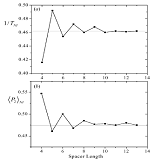S.D. Peroukidis, A.G. Vanakaras and D.J. Photinos, J. Chem. Phys., 123, 164904 (2005).
(Selected for the November 7, 2005 issue of Virtual Journal of Nanoscale Science & Technology.)
Abstract: Systematic efforts to synthesize fullerene-containing liquid crystals have produced a variety of successful model compounds. We present a simple molecular theory, based on the interconverting shape approach [Vanakaras and Photinos, J. Mater. Chem. 15, 2002 (2005)], that relates the self-organization observed in these systems to their molecular structure. The interactions are modeled by dividing each molecule into a number of submolecular blocks to which specific interactions are assigned. Three types of blocks are introduced, corresponding to fullerene units, mesogenic units, and nonmesogenic linkage units. The blocks are constrained to move on a cubic three-dimensional lattice and molecular flexibility is allowed by retaining a number of representative conformations within the block representation of the molecule. Calculations are presented for a variety of molecular architectures including twin mesogenic branch monoadducts of C-60, twin dendromesogenic branch monoadducts, and conical (badminton shuttlecock) multiadducts of C-60. The dependence of the phase diagrams on the interaction parameters is explored. In spite of its many simplifications and the minimal molecular modeling used (three types of chemically distinct submolecular blocks with only repulsive interactions), the theory accounts remarkably well for the phase behavior of these systems.
On the molecular theory of dimer liquid crystals
P.K. Karahaliou, A.G. Vanakaras and D.J. Photinos, Liq. Cryst., 32, 1397-1407 (2005).
 Abstract: We present a statistical mechanics approximation scheme for the explicit treatment of spacer-mediated configurational correlations among the mesogenic units that form a dimer molecule. The approximation is applied to the description of the nematic phase of linear uniaxial dimers interacting via a standard molecular pair-potential. Transition temperatures, order parameters and pair correlation averages are calculated for different spacer lengths. The results readily reproduce the experimentally observed trends of phase transition thermodynamics and of dipolar correlations deduced from dielectric studies.
Abstract: We present a statistical mechanics approximation scheme for the explicit treatment of spacer-mediated configurational correlations among the mesogenic units that form a dimer molecule. The approximation is applied to the description of the nematic phase of linear uniaxial dimers interacting via a standard molecular pair-potential. Transition temperatures, order parameters and pair correlation averages are calculated for different spacer lengths. The results readily reproduce the experimentally observed trends of phase transition thermodynamics and of dipolar correlations deduced from dielectric studies.
A.G. Vanakaras and D.J. Photinos, J. Mater. Chem. 15, 2002-2012 (2005).
Abstract: We present tractable molecular theory descriptions of liquid crystalline dendrimers based on clearly defined approximations and in terms of the dominant interactions underlying the self-organisation of these large and complex supermolecular entities. We formulate the configurational partition function for dendrimers, taking explicit account of their conformations and segmental interactions. Two approximate schemes are presented: the first is based on the effective interactions of the dendrimers as a whole while the second scheme is based on the interactions among the mesogenic units contained in the dendrimers. Results of lattice calculations for phase transitions in the context of the first scheme are presented and they show that the minimal inclusion of shape anisotropy and of sub-molecular partitioning into chemically distinct parts is sufficient to reproduce the variety of phases and phase sequences observed experimentally and provides insights into the conformational aspect of these transitions. In the second scheme, the description of the dendromesogenic system reduces to that of an ensemble of mesogenic dimers. This scheme can be readily extended to the description liquid crystalline oligomers and polymers consisting of mesogenic units connected by flexible spacers in various architectures. It thus provides a unified approach for treating mesomorphic phase transitions of supermolecular and macromolecular systems that can be built by connecting the same submolecular units in topologically different ways.
